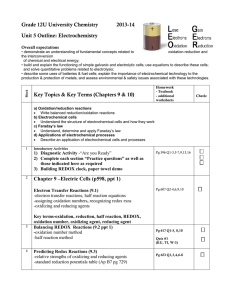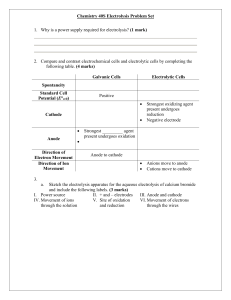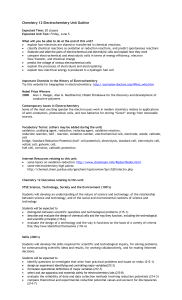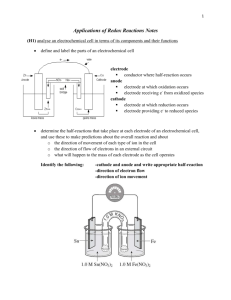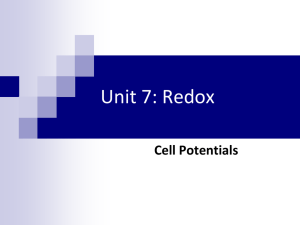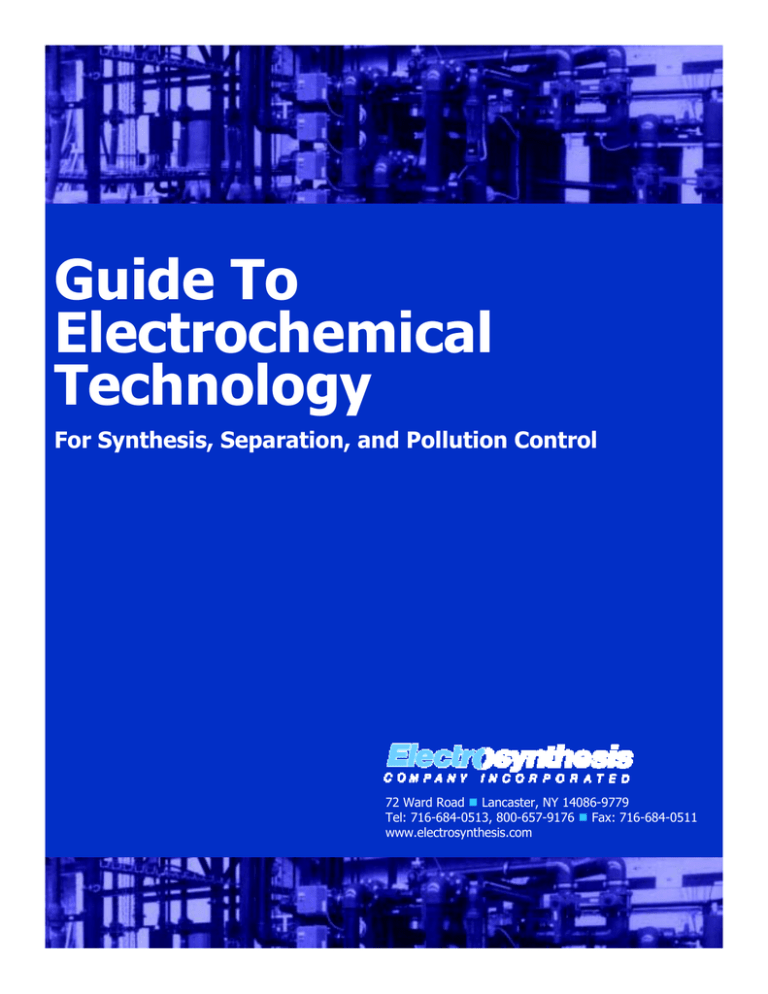
Guide To
Electrochemical
Technology
For Synthesis, Separation, and Pollution Control
72 Ward Road ! Lancaster, NY 14086-9779
Tel: 716-684-0513, 800-657-9176 ! Fax: 716-684-0511
www.electrosynthesis.com
Guide to Electrochemical
Technology
for Synthesis,
Separation and Pollution Control
Prepared for Electrosynthesis Company, Inc.
by Professor Derek Pletcher, University of Southampton
Chemical manufacturers and users are daily faced with decisions associated with
the need to improve chemical processes (e.g., increase selectivity, separate
difficult mixtures, decrease energy consumption, recover the value of chemicals in
waste streams, minimize the discharge of a toxic by-product, etc). Sometimes
appropriate technology is available, but often it is necessary to evaluate whether
an R&D program is likely to provide an economic and timely solution to the
needs of the company. A number of technologies may warrant consideration and
possible approaches may include electrolysis. Commonly, however, research
directors, plant managers, and other technical support providers have relatively
little knowledge of and/or experience with electrochemical technology. This
Guide seeks to show that modern electrochemical technology can offer the
preferred solution to a range of problems, and several illustrative examples are
described. On the other hand, electrochemistry is not the answer for all situations;
therefore the Guide also discusses those factors that should be considered to
determine whether electrolysis is a viable option.
© Electrosynthesis Company, Inc., 1999. All rights reserved.
72 Ward Road ! Lancaster, NY 14086-9779 ! Tel: 716-684-0513, 800-657-9176; Fax: 716-684-0511
www.electrosynthesis.com
Table of Contents
WHAT IS ELECTROLYSIS? .................................................................................................................. 3
APPLICATIONS OF ELECTROCHEMICAL TECHNOLOGY........................................................ 4
WHY CONSIDER ELECTROLYSIS NOW? ........................................................................................ 6
WILL ELECTROCHEMICAL TECHNOLOGY SOLVE YOUR PROBLEM? ................................. 7
EXAMPLES OF ELECTROLYTIC PROCESSES ................................................................................. 8
2
WHAT IS ELECTROLYSIS?
each mole of chlorine formed, two
moles of sodium hydroxide must also be
produced. Furthermore, it may be seen
that the rate of chemical change is
proportional to the cell current and the
total amount of product may be
calculated from the charge passed via
Faraday’s Law.
Electrolysis is a unit process in which
chemical change results from electron
transfer reactions across the
electrode/solution interfaces. A voltage
applied between the two electrodes in
an electrolytic cell drives these reactions.
A schematic of an electrolytic cell for the
manufacture of Cl2 and NaOH is shown
in Figure 1.
Overall, the process objective (the
conversion of sodium chloride to
chlorine and sodium hydroxide) is
achieved through two selective
electrode reactions and a selective
transport process through the
membrane. In common with all
processes, a chlor-alkali plant will need
several other unit processes to prepare
the feedstock for the cell and recover the
products. In a chlor-alkali plant, the
brine for the cell will be treated to
remove hardness and transition ions,
and then heated; the products are
converted into the appropriate form for
sale or downstream use.
e-
cation
exchange
membrane
Na+
e-
Cl- " ½Cl2
NaOH + H2
-
e
½ H2 + OH # H2O
CATHODE
ANODE
Cl2
NaCl
The technology for the chlor-alkali
process, including the design of the cell
and the development of highperformance cell components and the
other unit processes in a plant, has been
described,1 while a further series of
books cover the fundamental
electrochemistry, electrochemical
engineering and membrane
chemistry.2,3,4
Figure 1. Schematic representation of an electrolysis cell for the
manufacture of chlorine and sodium hydroxide.
The feedstock is aqueous NaCl brine,
fed to the anolyte compartment between
the anode and a cation permeable
membrane. Chloride is oxidized to
chlorine gas at the anode surface and
water is reduced to hydrogen gas and
hydroxide ion at the cathode. In order to
maintain charge balance, migration of
ions must occur, and the membrane is
designed to allow the passage of only
Na+ from anolyte to catholyte. As a
result, sodium hydroxide is formed in
the catholyte compartment. Also, in
order to preserve charge balance, the
rate of transfer of electrons at the two
electrodes must be equal – therefore for
D. Pletcher and F. C. Walsh, Industrial
Electrochemistry, Chapman and Hall, London 1990.
2 D. Pletcher, A First Course in Electrode Processes, The
Electrochemical Consultancy, Romsey, 1991.
3 F. C. Walsh, A First Course in Electrochemical
Engineering, The Electrochemical Consultancy,
Romsey, 1993.
4 T. A. Davis, J.D. Genders and D. Pletcher, A First
Course in Ion Permeable Membranes, The
Electrochemical Consultancy, Romsey, 1997.
1
3
APPLICATIONS OF
ELECTROCHEMICAL
TECHNOLOGY
The present commercial applications of
electrochemical technology are many
and diverse. Figure 2 is taken from a
recent EPRI report, Electrolytic Processes,
Present and Future Prospects,5 which
reviewed applications under the chapter
headings:
!
!
!
!
!
!
!
!
!
!
!
The Chlor-Alkali Industry
Metal Extraction
The Manufacture of Inorganics
The Manufacture of Organics
The Recycle of Chemicals and
Materials
Separation and Purification
Pulp and Paper
Water and Effluent Treatment
Atmosphere Control and
Improvement
Destruction of Toxic Waste
Soil and Groundwater
Remediation
!
!
While all this technology is based on the
same fundamental principles, its
practical manifestations may be quite
different with, for example, cell
configurations, electrode materials and
sizes, electrolytes and separators, which
are each designed to meet the particular
demands of the application. Even within
a particular heading, the processes may
be quite different. For example, consider
the manufacture of inorganic chemicals:
!
different sites. The chlor-alkali
industry is a major user of electric
power, consuming ~ 125 x 109
kWh/year, > 1% of the total
electricity generated. Not
surprisingly, energy consumption
is a major consideration in process
operation. Also, the scale of the
industry warrants the
development of highly optimized
cell designs and high-performance
anodes, cathodes and separators. A
modern cell house will be fully
automated and will operate
continuously without maintenance
for several years.
The world production of
potassium permanganate, KMnO4 ,
is only ~ 20,000 tons/year at a few
sites. Energy consumption is a less
important consideration in the
process economics, and the
electrolysis plant is more
traditional, without components
specifically developed for this
process.
Electrolysis is used for the on-site
manufacture of pure arsine, AsH3,
for the electronics industry. It
avoids storage of highly toxic gas
since the cells may be switched
on/off as the gas is required.
Highly automated and safe units
are operated on a very small scale.
A similar story could be told with
respect to the manufacture of organic
chemicals or with respect to the
technology for process stream recycle
and environmental protection. Thus,
electrolysis is used for the manufacture
of the polymer intermediate,
adiponitrile, at several sites with a total
world production of ~ 300,000
tons/year. It is also used for the
production of a number of fine
The world production of Cl2 is ~ 45
x 106 tons/year at some 700
5 EPRI Report, Electrolytic Processes, Present and Future
Prospects, Report Number TR-107022, December 1997.
4
Soil Remediation: in situ treatment of soils to remove
toxic materials.
Manufacture of Inorganic Chemicals: e.g., Cl2/NaOH,
KOH, ClO3-, ClO2-, BrO3-, H2, O2, F2, O3, H2O2, MnO2,
Cu2O, MnO4-, Cr2O72-, S2O82-, N2O5, NH2OH, SnO32-,
Ce4+, and AsH3.
Atmosphere Control: devices for removing toxic
substances or improving the O2 content of atmospheres.
Synthesis of Organic Compounds: including
monomers, fine chemicals, and pharmaceutical and
agrochemical intermediates.
Metal Finishing: e.g., electroplating, anodizing,
electropainting, and surface modification.
Extraction of Metals: e.g., Al, Na, K, Mg, Li, Cu, Zn, and
Ga.
Recycle of Chemicals and Process Streams: e.g.,
metal recovery and refining, recycle of redox reagents,
salt splitting, and electrodialysis for stream concentration.
Chemicals Purification and Separation: e.g., the
refining of metals, the separation of organics from
electrolytes, and purification of amino acids by
electrodialysis.
Manufacture of Electronic Components: e.g., printed
circuit boards, deposition of metal contacts, and
semiconductor layers.
Metals Fabrication: e.g., electrochemical machining,
electroforming, and electrogrinding.
Corrosion Control: e.g., anodic and cathodic protection
and sacrificial anodes.
Water and Effluent Treatment: e.g., salt removal; ClO−,
H2O2 and O3 treatment; removal of metal ions to < 1 ppm;
and removal of organics, nitrate and radioactive ions.
Total Destruction of Toxic Materials: e.g., destruction
of contaminated waste from nuclear industry, and
polychlorinated biphenyls.
Batteries and Fuel Cells: e.g., batteries for electronic
devices, household and portable devices, and fuel cells
for vehicles and on-site power generation.
Sensors: for monitoring atmospheres, warning of toxic
hazards, optimization of engine/furnace performance,
and monitoring water quality, process streams, medical
applications, etc.
Figure 2: Some industrial applications of electrochemistry.
chemicals (total productions 1,000 10,000 tons/year) as well as some
pharmaceutical and agrochemical
intermediates on a smaller scale. Quite
different approaches are available for
process stream recycle. These will
include electrolysis, electrolytic salt
splitting, electrodialysis, and salt
splitting with a special bipolar
membrane, and the choice will depend
on the nature of the problem to be
tackled and the specification for the
product streams. The same technology
can provide routes for the separation
and purification of products. In effluent
treatment and water purification, the
objective may be the removal of salts,
heavy or transition metals, toxic
organics or inorganics, or a reduction of
chemical oxygen demand (COD).
With such a variety of applications, it is
impossible to make generalizations that
will stand detailed examinations.
However, there are certainly several
myths about electrolytic processes that
should be refuted. For example:
Myth #1: Electrolytic processes are
very large consumers of electrical
energy. This is only true for very largescale processes such as Cl2/NaOH and
Al production. In the manufacture of
fine and specialty chemicals, the cost of
electric power is a minor part of the
process cost. More commonly, the
economics are dominated by the cost of
the feedstock, and the process will be
designed to give the highest product
selectivity.
5
Myth #2: Electrolysis cells are
unreliable and expensive. Modern
electrolysis plants can be fully sealed,
automated, and computer-controlled
and operate continuously for many
months, even years. Moreover, cells
need not be expensive, particularly if
precious metal electrodes and
perfluorinated membranes can be
avoided.
!
!
!
Myth #3: Electrolysis cells are difficult
to obtain. No! A number of companies,
including Electrosynthesis Company,
Inc., now market electrolytic cells, and
there are also many companies which
supply electrode materials and coatings,
membranes and separators, etc.
Moreover, the understanding of cell
design has matured significantly during
the last 20 years, and implementing a
new cell design to meet the needs of a
particular process is much simpler.
!
Electrolysis should be selected as the
preferred method because it has
advantages over competitive chemical
routes.
WHY CONSIDER
ELECTROLYSIS NOW?
As you evaluate conventional
processing methods, we suggest that
you should be including consideration
of electrolysis for the following reasons:
!
!
!
< $0.01 compared to $0.03 - $3.00
for common redox reagents.
Conditions for a wide range of
highly selective transformations
are known.
Methods are available for chiral
synthesis.
Suitable electrolytic cells are
available off-the-shelf, and these
may be combined with other
necessary unit processes to
construct fully integrated and
compact production systems,
which may be batch or
continuous. Also, electrolytic
processes are easily computercontrolled.
A wide range of modern cell
components is now available,
providing answers to problems
that previously limited process
performance.
There are limitations on electrochemical
technology, and there are unique
solutions that overcome many of these
limitations. For example, in a direct
electrolysis, the maximum rate of
chemical change per unit area of
electrode (the current density) is
proportional to the concentration of
reactant in solution. An economically
viable current density often requires a
high solubility of reactant. Since many
reactants are often relatively insoluble in
aqueous electrolytes (the preferred
medium for commercial electrolysis), it
has been necessary to develop strategies
to minimize this limitation. One widely
successful approach is indirect
Electrolysis can be a selective,
convenient and cost-effective
technology for synthesis,
separations, and pollution
control.
Electrodes bring about chemical
change without the use of toxic
reagents and usually in
conditions close to ambient
temperature and pressure.
Electrons are cheap reagents.
The cost of a mole of electrons is
6
electrolysis, where a redox mediator (a
redox couple soluble in water) is used to
transfer the electrons between the
electrode and the reactant. Essentially
the active oxidation state (for oxidation
or reduction) is continuously generated
at the electrode and allowed to react
with the substrate away from the
electrode, either in-cell or ex-cell. Many
indirect electrolyses employ multiphase
conditions. Couples used successfully
for oxidation include Ce3+/Ce4+,
Cr3+/Cr2O72-, Mn2+/Mn3+, and
Os(VI)/Os(VIII) couples with chiral
ligands. The redox species are always
recycled; hence, only small amounts of
redox reagents are used and there is no
stoichiometric by-product stream from
the redox reagent. Other approaches
include three-dimensional electrodes
and the use of gas diffusion electrodes
for gaseous reagents.
!
!
!
!
!
WILL ELECTROCHEMICAL
TECHNOLOGY SOLVE YOUR
PROBLEM?
Of course, there can be no general
answer to this question. It will depend
on your specific requirements and the
ability of both electrochemical
technology and competing approaches
to meet your challenge. Clearly, for
electrochemical technology to be your
chosen route, there must be a reasonable
match between the capabilities of the
technology and your technical needs.
We have already cautioned about
generalizations and myths about
electrolytic processes. Furthermore, we
would reiterate that there have been
significant advances in the availability
and performance of cells and cell
components as well as in knowledge of
electrode reactions and electrochemical
engineering; overall, it is now easier to
take a process through to commercial
operation. The key to success in an R&D
program is to select an appropriate
approach and to identify how modern
components and concepts can be
Many kinds of electrochemical
applications are now commercial
realities for process stream recycle,
product isolation, and water and
effluent treatment, including:
!
!
!
!
!
The concentration of transition
metal ions from plating wash
waters (ED).
The conversion of waste salt
streams to acid and base (either
by electrolysis or bipolar
membranes).
Recovery of pure NaCl from
seawater (ED).
Isolation of pure organic acids
from chemical streams (ED).
On-site electrogeneration of ClO-,
H2O2, and ozone for effluent
treatment.
Removal of heavy, transition, and
precious metals from effluent to
levels << 1 ppm.
The removal of many organics,
commonly to a COD < 10 ppm.
The decolorization or
detoxification of effluent streams
by selective oxidation/reduction.
Removal of salinity from water to
< 200 ppm (by electrodialysis,
ED).
The selective removal of ions –
e.g., NO3- from aqueous solutions
using special membranes (ED).
7
EXAMPLES OF ELECTROLYTIC
PROCESSES
applied. If you or your colleagues are
unfamiliar with the field, we would
strongly recommend that you talk to a
suitable consultant or approach an
organization with knowledge and
experience in developing electrolytic
processes.
(a) The Synthesis of an Intermediate for
the Cephalosporin Antibiotic,
Ceftibuten6
The reaction in Figure 3 was identified
Below, you will find several examples of
as a step in the conversion of the readily
successful electrochemical processes
available cephalosporin C and the third
developed in recent years.
We have deliberately
O
O
O
O
stressed the key features
O
O
H H
H H
HO
NH
S
that make them successful
HO
NH
S
and also tried to give you
+ 2eN
N
CH2OCOCH3
O
O
some idea of what the
- CH3COOCOOH
COOH
plants might look like. We
hope that you will find
Figure 3. A step in the conversion of cephalosporin C to third generation cephalosporin
antibiotics.
them interesting, although
we would not necessarily
generation cephalosporin antibiotics.
expect there to be close analogies
Preliminary studies showed that the
between the examples and your
highest yields of the product from the
requirements. They are intended only to
electrochemical reduction were obtained
illustrate the possibilities.
with an aqueous phosphate buffer, pH 7
- 8, and a temperature ~ 280 K. The
reduction was always accompanied by
significant H2 evolution, which lowered
the current efficiency. The preferred
cathode material was tin, and it was
found advantageous to use an extended
area tin cathode fabricated from tin
mesh since this gave improved mass
transport of the reactant to the cathode
in a flow cell. A compact and convenient
pilot plant was built based on a
commercial electrolyzer, the FM21-SP
(marketed by ICI). It had a cathode
made by welding expanded Sn mesh to
both sides of a Sn plate, giving a
nominal cathode area of 0.42 m2. The
6 G. D. Zappi, 12th International Forum on Electrolysis in
the Chemical Industry – Clean and Efficient Processing,
Sheraton Sand Key, Clearwater Beach, Florida,
October 1998.
8
unit had DuPont’s stable perfluorinated
cation exchange membranes and
catalyst-coated titanium anodes suitable
for O2 evolution placed on either side of
the cathode. The flow circuit was based
on one 100-gallon fiberglass anolyte (0.5
M H2SO4) tank, a 30-gallon polyethylene
catholyte tank, a heat exchanger, and a
recirculating cooler. The system used a
1000 A power supply and a number of
safety devices and sensors to allow
automatic shutdown in the event of
process malfunctions. The pilot plant
was operated batchwise but unattended
during electrolysis; each batch
converted ~ 3 kg of starting material.
With current densities of 1.2 - 2.0 kA
m-2, the batch time was 10 - 12 hours; the
conversion was 99% and the chemical
yield ~ 95%. The development of this
process from very preliminary
laboratory scale to completion of the
pilot plant trials took ~ 20 man months.
drivers were high selectivity at full
conversion (reflecting the high cost of
starting material) and high product
purity; both requirements were
achieved in the electrochemical process.
(b) The Production of
Aminoanthraquinone7
For some years, Hydro Quebec has been
developing indirect electrolytic
processes for the manufacture of organic
compounds where the electrochemical
step is the oxidation of Ce(III) to Ce(IV)
in aqueous methanesulfonic acid. This
medium is advantageous because of the
high solubility of the cerium salts which
allows a higher current density and
gives higher rates for the reaction
between Ce(IV) and the organic
substrate. An early target was the
production of anthraquinone where the
Ce(IV) was reacted with naphthalene.
More recently, a process for the
production of aminoanthraquinone has
been described. The route envisaged
was:
It is valuable to point out two further
features of this process. First, it would
have been preferable to carry out the
reduction with equivalent substrate
with the cephalosporin ring structure
itself, but the reduction of the substrate
then gives a significant amount of byproduct. It was therefore worthwhile to
carry out a peracid oxidation to form the
sulfoxide prior to cathodic reduction (a
type of decision familiar to synthetic
chemists). Second, although the current
efficiency was reasonable at low
conversions, it became low at full
conversion. It was, however,
advantageous to the downstream
processing to ensure full conversion.
The low current efficiency was
acceptable because the energy
consumption was not at all significant to
the process economics. The economic
NO2
NO2 O
NO2 O
Ce(IV)
O
O
NH2 O
Na2S
O
Ce(III) - e- " Ce(IV)
The electrochemical regeneration of the
Ce(IV) oxidant has been carried out in
three different commercial electrolyzers,
7 S. Harrison, 10th International Forum on Electrolysis in
the Chemical Industry – The Power of Electrochemistry,
Sheraton Sand Key, Clearwater Beach, Florida,
November 1996.
9
(c) The Manufacture of Hydriodic Acid8
and in each it was possible to achieve a
current efficiency of 92 - 95% for a 70%
conversion of a 1 M solution of Ce(III) at
a current density of 4 kA m-2. Again, the
cost of the nitronaphthalene was the
largest factor in the process economics;
therefore, it was critical to optimize the
chemical yield of the reaction sequence.
Two-phase conditions were identified
for conversion of the nitronaphthalene
to nitronaphthoquinone in a chemical
yield of ~ 95% at a conversion of 99%.
The Diels-Alder reaction and final
reduction were also shown to give high
chemical yield.
The requirement was for very high
purity 57% HI. The conventional
chemical process employed reduction of
iodine with red phosphorus, a difficult
technology with effluent problems.
Some years ago, an electrochemical
process was described. Iodine was made
soluble in the catholyte by complexation
with HI, and the cathode reaction was
I3− + 2e- " 3I−
and the anode reaction was
2H2O - 4e- " O2 + 4H+
A pilot plant was built and operated.
The regeneration of Ce(IV) and the
coupled oxidation of nitronaphthalene
were carried out continuously over a
period of 750 hours, and the yield of
nitronaphthoquinone was maintained at
90%. The other chemical steps were
carried out batchwise in 600 - 750 liter
reactors, and high-quality
aminoanthraquinone was isolated.
in a cell with a perfluorinated cation
exchange membrane and a sulfuric acid
anolyte so that H+ migrated through the
membrane. The process, however, had
problems associated with shortcomings
in membrane performance. Some sulfate
passed through the membrane, leading
to unacceptable sulfate contamination of
the HI product. In addition, some iodide
passed from catholyte to anolyte where
its oxidation led to insoluble iodine and
fouling of the membrane. A recent
development overcame these problems.
The key change was to the anolyte,
which became iodic acid; the major
anode reaction remained the evolution
of oxygen but some oxidation
A plant with an annual production of
3,300 tons was designed and costed. The
electrolyzer required a total anode area
of 120 m2 which could be constructed as
a “black box” unit, ca 1 m x 1 m x 2 m.
Raw materials represented 70% of the
production costs, and the total direct
manufacturing cost $3,370/ton of
aminoanthraquinone (assuming that the
cost of nitronaphthalene as $2,200/ton).
The total equipment (electrochemical +
chemical) cost was estimated as $11
million.
IO3− + H2O - 2e- " IO4− + 2H+
also occurred. As a result, any iodide
reaching the anolyte was consumed
3IO4− + I- " 4IO3−
J. D. Genders, 10th International Forum on Electrolysis
in the Chemical Industry - The Power of Electrochemistry,
Sheraton Sand Key, Clearwater Beach, Florida,
November 1996.
8
10
production of drinking water. These can
be very large plants producing several
thousand cubic meters of high-quality
water per day from brackish feedstock
and tens of thousands of square meters
of membranes with up to 500 membrane
pairs in each cell unit.
before it was oxidized at the anode.
Therefore, the fouling problems were
overcome. With no sulfate in the cell, it
cannot contaminate the HI product
while any iodate or periodate passing
through the membrane into the
catholyte would react with iodide to
reform iodine, leading only to a slight
loss in current efficiency.
A further interesting development has
been the introduction of membranes
with some selectivity of ion transport.
One such membrane is Neosepta ACS
(Tokuyama Corp.) which gives
selectivity for NO3- with respect to SO42-.
Eurodia Industrie S.A. has employed
these membranes in its units for
removing nitrate from drinking water
(nitrate in drinking water is an
increasing problem, especially in
Europe). Eurodia Industrie has also
sought to advance cell component
design and has incorporated optimized
designs into the electrodialysis stacks
for 5 commercial plants around Europe.
These produce 250 - 4000 m3 of treated
water per day and contain 200 - 4000 m2
of membrane, usually in 2 - 4 stacks.
Typically, they reduce the nitrate level
from 100 - 150 ppm to 10 - 30 ppm.
Based on EUR 20 electrodialysis stacks,
the investment cost varies between $150
- 300 m-3 per day depending on plant
size (500 - 4000 m3 treated water per
day) and the fraction of nitrate removed
(0.65 - 0.85). The total operating cost,
including membrane replacement and
electric power consumption, lies in the
range of $0.05 - 0.10 m-3.
Clearly, it was desirable to carry out the
reduction of HI3 to complete conversion,
and this was achieved in a two-cell
system. The major part of the
conversion (I2 concentration decreased
from 4.6 M to 0.4 M) was carried out in
the “production cell,” a conventional
plate and frame cell with graphite plate
electrodes. The catholyte from this cell
then passed to a “polishing cell” with a
three-dimensional cathode fabricated
from graphite felt. Overall, the two-cell
process led to 57% HI with a very high
specification including an iodine content
< 10 mM. The yield based on iodine was
close to 100%, and the overall current
efficiency was 90%. Note that the
process has no unwanted effluents. A
pilot plant was operated for 1000 hours
without any significant drop in
performance, and a full-size plant was
then designed.
(d) The Selective Removal of Nitrate
from Water4,9
A major development of the past twenty
years has been the introduction of largescale electrodialysis plants for the
9 B. Gillery, 12th International Forum on Electrolysis in
the Chemical Industry – Clean and Efficient Processing,
Sheraton Sand Key, Clearwater Beach, Florida,
October 1998.
11
(f) The Recovery of Copper from Effluent
in the Scottish Whiskey Industry1,10
A number of companies market
electrochemical technology for the
removal of transition, precious,
and heavy metal ions from
effluents. Moreover, the
electrolytic cells are based on
quite different cell concepts, and
the process objectives may either
be the recovery of metal value or
for the effluent to meet legal
requirements for discharge. Here,
we will illustrate this technology
with an example that employs the
RenocellTM (formerly known as
PorocellTM).
robust, and inexpensive design and
these are sold as a complete unit. The
size of a typical unit is 1 m long and
0.18 m in diameter.
Solid polymer disc
Polypropylene pipe
1 m long x 0.18 m diameter
Cylindrical anode, usually expanded Ti mesh
with catalytic coating for O2 evolution
Cylindrical carbon
felt cathode
Effluent flow
Figure 4. Schematic of the Renocell metal recovery cell.
Renocell is based on a threedimensional cathode fabricated from
graphite felt with a very high surface
area/unit volume. It has cylindrical
geometry and is usually undivided; it is
shown schematically in Figure 4.
Cylindrical, carbon felt cathode is
surrounded by a cylindrical mesh
anode, usually an expanded Ti mesh
with a precious metal oxide coating
catalytic for O2 evolution. The effluent
flow is directed through the cathode by
the solid polymer disc at the top. This
flow through the cathode gives uniform
mass transport throughout the cathode
surface and a reasonable mass transfer
coefficient. The cell is fitted into a
polypropylene pipe whose inlet/outlet
have quick-release couplings so that the
cathode, designed as a cartridge, may be
changed rapidly when it is fully loaded
with metal. The cartridges are a simple,
In the Scotch whiskey industry,
distillation is carried out in copper pot
stills, and this leads to an effluent
stream contaminated with Cu(II). At
Invergordon Distillers, this leads to
7 m3/hour of an effluent stream known
as “spent lees” containing 10 - 30 ppm of
Cu(II). The “spent lees” contains a high
concentration of organics but little
electrolyte, and it exits the distillation
unit at 85o C. Despite low conductivity,
the Cu(II) concentration is decreased to
< 1 ppm by a Renocell unit. The unit has
5 cells in parallel, and has a footprint of
0.5 m x 0.75 m. The unit continuously
operates, removing ~ 2 kg/day of
copper, and cartridges are replaced
every month. Cathodes are then loaded
with some 10 - 20 kg of copper and are
sent away for copper recovery. Renocell
units operate in many countries on a
wide range of metals including
precious, transition, and heavy metals,
producing exit streams that are
acceptable to the local environment.
G. Sunderland at The 8th International Forum of
Electrolysis in the Chemical Industry - Applied
Electrochemical Technology, Lake Buena Vista, Florida,
November 1994.
10
12
a)
H+
anion
exchange
membrane
cation
exchange
membrane
Na+
-
X
NaOH
OH-
CATHODE
HX
ANODE
(g) The Recovery of
32% Sodium
Hydroxide from a
Waste Aqueous
Sodium Sulfate
Stream11
Current Efficiency (%)
Many processes
produce an effluent
NaX
stream, which is
essentially an
aqueous solution of
b)
a pure salt in high
100
concentration. Even
when the stream is
90
sodium sulfate, it
often cannot be
discharged, and an
80
attractive option
Sodium
Ammonium
Hydroxide
Sulfate
can be to convert
70
the stream back to
Anion Exchange Membrane: Neosepta AMH
acid and alkali. In
60
Cation Exchange Membrane: Nafion 902
DSA - oxygen anode, Ni cathode
principle, this can
be achieved with
50
20
25
30
35
40
45
either electrolysis or
Concentration (wt %)
bipolar membranes,
although with the
latter approach, the
Figure 6 (a) A common cell configuration for salt splitting; i.e., converting a salt to acid and
base. (b) Current efficiency as a function of product concentrations for the Electrosynthesis
concentration of
Co/Ormiston Mining process.
acid and alkali
which can be
2H2O - 4e- " O2 + 4H+
produced is limited to ~ 5%. One
electrolytic approach is based on a
2H2O + 2e- " H2 + 2OH−
three-compartment cell with both anion
and cation permeable membranes (see
and the acid, HX, and base, MOH, are
Figure 6). The salt stream is fed to the
formed by migration of X− and M+
central compartment between the anion
through the anion and cation permeable
and cation permeable membranes.
membranes under the influence of the
Proton and hydroxide ions are
potential field between the electrodes.
produced at the anode and cathode
The limitation of this approach is the
respectively by the reactions
characteristics of the anion permeable
membrane. Such membranes do not
have a high transport number when
11 J. D. Genders and J. Thompson, US Patent (1992)
contacted by a high proton
5098532.
13
concentration. Therefore, while a good
current efficiency for the process is
possible initially, once the acid
concentration in the anolyte begins to
build up, back-migration of protons
occurs (i.e., protons transfer from the
anolyte into the center compartment
instead of sulfate transporting in the
opposite direction). Only a limited acid
concentration can be formed, and as
protons build up in the center
compartment, they start to pass through
the cation permeable membrane as well
and this limits even the caustic soda
concentration.
sulfate. These conditions prevail in the
Canadian Midwest.
Conclusion
Electrochemical technology has become
an important processing tool for
synthesis, separations, and pollution
control. Electrochemical cells and
sophisticated cell components are
readily available, as is the technical
expertise to assist you. Many examples
are now well-documented commercial
realities, and many more are advancing
through piloting toward commercialization. We hope this Guide has been
useful in presenting the importance of
considering electrochemical technology,
along with conventional processing
options, from the earliest stages of your
product or process development
analysis.
The Electrosynthesis Company, Inc., in
conjunction with Ormiston Mining in
Saskatchewan, found a convenient
solution to this limitation. Ammonia
was added continuously to the anolyte
tank so as to maintain the anolyte at pH
2. The overall process then becomes
4NH3 + 2Na2SO4 + 4H2O "
4NaOH + 4(NH4)2SO4 + 2H2 + O2
and in these conditions, a good current
efficiency is maintained to high
concentrations of both ammonium
sulfate and sodium hydroxide. The
process was scaled up in a cell designed
by the Swedish company ElectroCell,
with electrode areas of 0.4 m2. The
electrodes were plates, the cathode was
nickel, and the anode was an O2evolving coated titanium. The process
was operated at 2.5 kA m-2. Good
performance was achieved over
extended trials, and it was possible to
manufacture 35% sodium hydroxide.
Clearly, the process is only appropriate
where cheap ammonia is available and
there is also a market for ammonium
14
Electrosynthesis Company, Inc. has performed contract R&D
with over 200 groups within companies, government
institutions, and independent laboratories since 1977.
Our internationally recognized expertise in electrochemistry
gives our clients fast-track technology development and
competitive advantage at affordable cost.
We welcome your comments on this Guide and look forward to
working together with you on your next
electrochemical R&D project.
Copyright © 1999, Electrosynthesis Company, Inc. All rights reserved.
15



